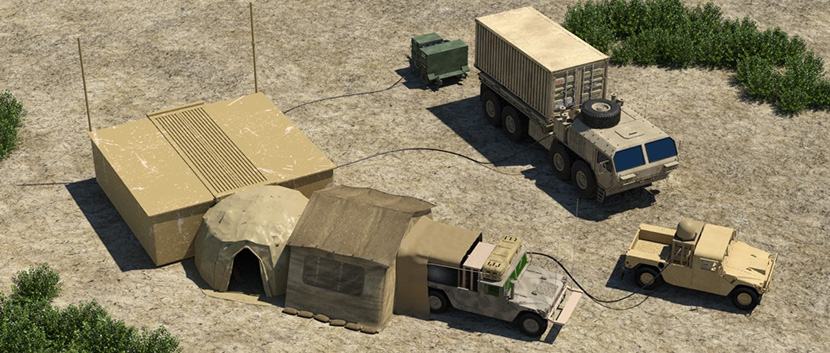The U.S. Army Works Transformation: Focus on Command Post Mobility
As the U.S. Army deals with 21st century threats posed by authoritarian powers and movements, mobility of forces and of command and control of those forces becomes a central consideration.
According to Mark Kitz, the PEO of the Army’s Office of Command, Control and Communications-Tactical has underscored:
“We learned a significant lesson in Ukraine, right? You have to move. These lower echelons, below the division, their command posts have to move to be survivable. They have to be dispersed to be survivable. The command posts that we were building and architecting, with the network as an enabler, clearly would not be survivable in a large-scale combat operations fight.”
As Kitz underscored one of the key elements is working a division sized approach to mobile C2 capabilities. The division is the focus of action for network design. A key element which the Army is focused upon is what they call CP12 or Command Post Integrated Infrastructure.
The office headed by Kitz has produced a very instructive web tutorial with regard to how they are looking at CP12.
“As one of the Army’s top priorities for network modernization, the CPI2 program addresses the challenges posed by contemporary and future land conflict, such as physical signatures, mobility and standardization. Command post designs for this effort are integrating approved commercial and government off-the-shelf systems, as well as government programs of record that support command post operational needs.”
They are taking a wholistic look at the challenge of creating such mobile command posts for signature management and force integration beyond simply what Army communication systems can provide is required.
This is how they described the integrated capabilities which are required:
“CPI2 leverages improvements in technology to reduce the current CP footprint and improve mobility and agility. It consists of the integration of approved and fielded mission command information systems, government-off-the-shelf (GOTS) and commercial off-the-shelf (COTS) technology that support the operational needs of the corps, division and brigade combat team (BCT) main and tactical CPs, and the BCT battalion CPs.
“The centerpieces of CPI2 are the Mission Command Platform (MCP) and Command Post Support Vehicle (CPSV). CPI2 also provides all the ancillary equipment for fully outfitting the mobile CP, including the CPI2 Integrated Support System (ISS), tents, environmental control units (ECUs), power generation, displays, tables and chairs.
“Mission Command Platform (MCP): The MCP provides digitally connected workstations to support staffs at CPs, as well as command groups at corps, division, and BCT. The MCP uses current program of record (PoR), GOTS and COTS systems to plan, prepare, execute and assess operations.
“Command Post Support Vehicle (CPSV): The CPSV hosts mission command servers, radios, local area network (LAN) systems and a Unified Voice Management System (UVMS) for conferencing, access to tactical voice radio, Voice over Internet Protocol (VOIP) telephone, and radio cross banding.
“Integrated Support System (ISS): CPI2 will develop or acquire the Command Post Display System (CPDS) and UVMS. The CPDS, with its accompanying software, will support enhanced collaboration and communication by allowing the commander and staff the option to view multiple common operating pictures (COPs) simultaneously. The UVMS provides data communication exchange between Army standard network and radio protocols within and between the mobile CPs.”
In other words to shift from the fixed command posts of the Middle Eastern wars to the kind of command posts necessary to operate a multi-mission more expeditionary force requires significant integrated change across not only the Army but in line with the services and allies as they shape more distributed forces that can integrate the desired combat effects.
The Army News Service highlighted this shift in 22 December 2023 article:
“The Army is designing the network architecture to address the need for forces to be constantly moving on the battlefield, with units articulating a preference for on-the-move versus at-the-halt capabilities.
“To advance C2 on the move, the Army is reducing static command posts and infrastructure to improve survivability and to better support commanders’ ability to make decisions and exercise C2 while dispersed and mobile. The Army is soliciting industry over the next year for potential options to reduce the footprint of command posts for larger units and echelons.
“During a recent Joint Multinational Readiness Center training exercise in Germany, Col. Rob McChrystal, commander of the 2nd Cavalry Regiment, said that his unit was able to disperse 70 percent of a brigade command post over the horizon 60 miles away.
“[To be] survivable, we need to be transport agnostic,” McChrystal said during TEM11. “I’m talking about redundancy and maximum options; whether it’s transport from the terrestrial layer to multiple types of Low Earth Orbit to Medium Earth Orbit to Geosynchronous Earth Orbit. We need to have those options, and ultimately we want to get to the point where that’s automated, and we’re able to auto transition when they fail.”
“McCrystal also noted that implementing a new C2 paradigm means that even though he commands a highly mobile Stryker unit, he will need something that is a smaller form factor and transport agnostic to allow his troops to disperse.
“Preparing for LSCO spurred the Army to make institutional changes and determine which core capabilities are appropriate at echelon, while enhancing key objectives such as C2 on the move, securely sharing information across the Mission Partner Environment and creatively operating under successful electromagnetic signature management to ensure Soldiers conducting maneuvers are imperceptible to adversaries.
“We are an Army in transition, and it’s an exciting time with a lot of opportunity for everybody in this room, but I would encourage all to have a real sense of urgency,” Morrison said. “We’ve got to get this right and continue to mature the network that we have so that we don’t fight with the network, we actually provide a C2 system that allows the commander to command.”

